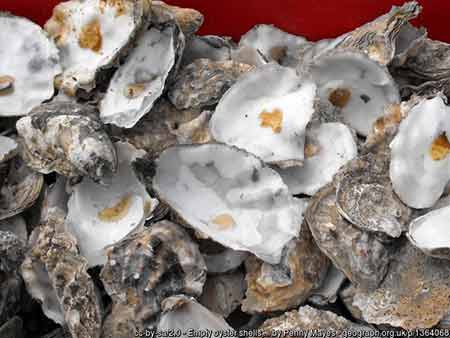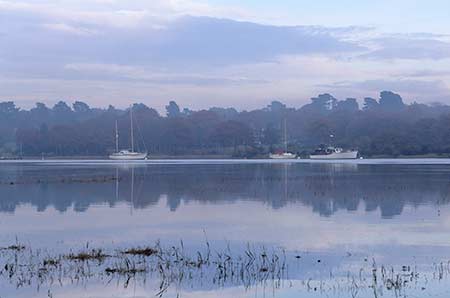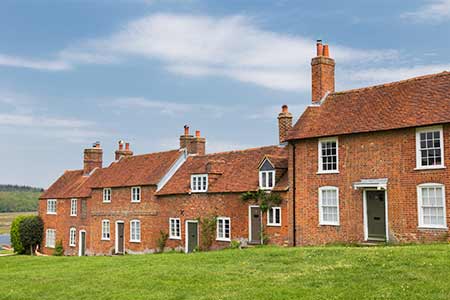Beaulieu Oyster Beds - a 19th century enterprise
Oysters are now often considered to be a gourmet's delight, the province of those who enjoy and can afford fine dining, but for many years up to the first half of the 19th century, and in places later still, they were a staple part of the diet of poorer members of society.
But what may come as more of a surprise to many people is that oyster beds were once present along the Solent and in the lower reaches of the Beaulieu River.
(1) Oysters - a bit of background
The cultivation of oysters for human consumption has a long and illustrious history dating back to at least Roman times in the 1st century BC, and a little later to the Roman occupation of Britain between AD43 and AD410.

Oyster shells were discovered, for example, during excavations along the south coast from Beaulieu at Fishbourne Roman Palace, near Chichester; and at Rockbourne Roman Villa, near Fordingbridge, a little beyond the New Forest boundary away to the west.
However, the Roman and Romano-British peoples did not consume all of the local oyster harvest, for oysters were also exported live to Rome.
The Domesday Book, an ambitious land survey commissioned by William the Conqueror in 1085, not long after the Norman Conquest, records fisheries, which have been interpreted by some as oyster beds, in the New Forest area at Eling and Dibden on Southampton Water, and at Stanswood, near Calshot.
By the middle of the fourteenth century there are references to Hampshire oyster beds at Emsworth; Hayling Island; in the Beaulieu estuary, most likely near to Needs Ore; and across the Solent on the Isle of Wight at Wootton Creek, Newtown Harbour and in the Medina estuary.
Oysters were also taken from the wild, at times in huge numbers. On one tide alone during 1760 a reported 24,000 oysters were dredged from the harbour at Emsworth, on the south-east Hampshire coast; whilst 28 years later, over 7,000 bushels of native Emsworth oysters were apparently raked and dredged from the harbour.
During the first half of the 19th century, and in some places later still, oysters were plentiful and cheap, and were consequently popular with those who could not afford regular wholly meat-based dishes.
However, perhaps not surprisingly, over-fishing exhausted the contents of many natural oyster beds and what had previously been a food of the poor became a delicacy afforded primarily by the wealthy.
But how times change, for early in the 21st century, the Solent Oyster Restoration Project was conceived, managed by Blue Marine Foundation - a charity dedicated to restoring the world's oceans, to bring together scientists, fishermen, conservationists, local industry and volunteers with the aim of restoring five million oysters to the Solent over a five year period. And so for now, the future for oysters in the Solent seems to be remarkably brighter than for a great many years.
(2) The Beaulieu River Oyster Beds
In 1879, or thereabouts, at a time when oysters were considered a delicacy that consequently offered the potential for profit, Henry Scott, Lord Montagu, took initially tentative steps into the heady world of oyster cultivation.
The lower reaches of the Beaulieu River seemed to provide suitable growing conditions for these hard-shelled, salt water molluscs that feed by filtering suspended plankton and other particles from the water - they seemingly thrive best in brackish water where there is protection from the worst of the seas but still a tidal current to bring in their food.

A little downstream from Buckler's Hard, near Clobb Copse, two large rectangular oyster beds lined with tiles were dug out. Banks and sluices were incorporated to control the flow and level of water.
The beds were operated from 1880 in partnership with Major Alexander Boyle, of Cowes, who already owned and operated oyster beds at Newtown, Isle of Wight, and at Fishbourne.
Known as the Newtown and Beaulieu Oyster Fishery Company, the partnership, however, failed to achieve commercial success as a result of disappointing sales and high costs - never a good combination - in part, at least, as a result of inappropriate design, management and operation of the beds, including stocking with French oysters, a variety that did not take well to life in Hampshire waters.
The partnership was therefore short-lived - in July 1886, at an extraordinary meeting of shareholders, it was agreed that excessive liabilities were making it impossible to continue to trade and the Company should go into liquidation.
The oyster beds were still in existence in 1905, however, but had ceased operation by 1906.

D.T. Alston, who from 1848 lived in the east terrace at Buckler's Hard - at the present number 87, the old Ship Inn - was described as an innkeeper and agent for the oyster fishery.
By 1867 William Martin, also resident at number 87, was described as a fisherman and oyster agent, but not an innkeeper.
Kelly's 1898 Directory has an entry for Beaulieu Oyster Fisheries (Ethelbert Collins, manager), and in 1905 the soon to be defunct oyster beds were cared for by Thomas Smith, who also lived at Buckler's Hard.
As happened in many other places along the lower reaches of the Beaulieu River, the site of the old oyster beds was pressed into service in World War Two, in this case for the construction of parts of Mulberry Harbours that were to be towed across the English Channel in support of the D-day landings of June, 1944 - these were temporary portable harbours that would enable the rapid off-loading of men, equipment and supplies onto the Normandy beaches.
References:
Bucklers Hard - a rural shipbuilding centre: A.J. Holland
An Album of Old Beaulieu: Susan Tomkins
The Emsworth Oyster Industry - A Short History
Kelly's Directory
Various Wikipedia pages
Quick links
More links
Search this site

